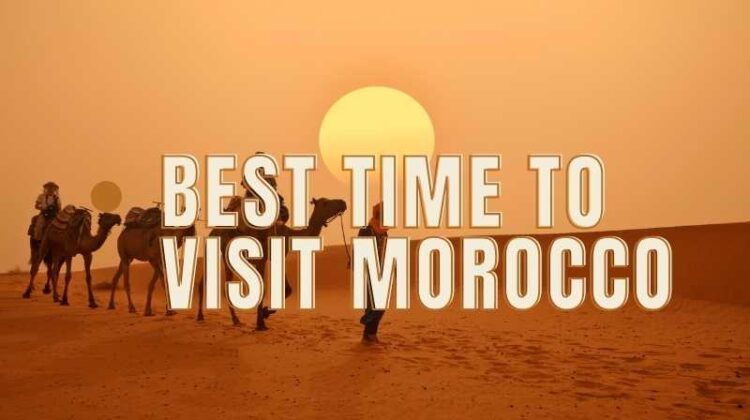
Morocco, a land of breathtaking natural beauty, rich history, and vibrant culture, awaits the adventurous traveler.
From the bustling streets of Marrakech to the serene deserts of Merzouga, Morocco offers an array of experiences.
To fully savor every moment of your trip, you must consider the climate and seasons when planning your visit. In this comprehensive guide, we provide you with all the essential information to choose the best time to explore Morocco.
Table of Contents
Morocco’s Climate and Seasons
Morocco boasts a Mediterranean climate, characterized by hot, dry summers and mild, rainy winters. Yet, climate variations are significant, influenced by region and altitude.
Coastal destinations like Casablanca and Rabat enjoy relatively mild temperatures year-round. However, the Atlas Mountains can become quite chilly in winter, while the Sahara Desert sizzles in the summer heat.
Spring in Morocco (March to May)
Spring in Morocco, from March to May, offers mild weather with temperatures ranging from 15°C to 25°C. It’s an ideal time to visit, with lush green landscapes and blooming flowers, setting the stage for a delightful experience.
Summer in Morocco (June to August)
Summer, from June to August, can be exceptionally hot, with temperatures soaring up to 40°C in some areas.
It’s the peak tourist season, perfect for coastal regions, such as Essaouira, Agadir, and Tangier, known for their Mediterranean climate and warm, sunny beaches. However, inland cities like Marrakech and Fes can become scorching.
Fall in Morocco (September to November)
Fall, from September to November, brings warm and sunny weather, with temperatures ranging from 20°C to 30°C.
This season provides an excellent opportunity for travel, with fewer crowds after the busy summer season and delightful weather.
Winter in Morocco (December to February)
Winter, from December to February, is the coldest season, yet still comparatively gentle compared to many other parts of the world.
Expect temperatures between 10°C and 20°C. It’s an excellent time to explore cities and historical sites without the summer heat and crowds.
Choosing the Best Time to Visit Morocco
Best Seasons Overall
For those seeking comfortable temperatures, pleasant weather, and fewer crowds, spring and fall are the best seasons to visit Morocco.
These times are also ideal for city exploration, cultural site visits, and outdoor activities like hiking and trekking.
Best for Beach goers and Sun-Seekers
Summer is the peak tourist season, perfect for beach enthusiasts. Coastal towns offer Mediterranean climates with warm, sunny days, ideal for swimming and surfing. However, if you choose to visit Morocco during summer, it’s advisable to pack light and breathable clothing.
Best for Skiing and Snowboarding
Winter is the best time for skiing and snowboarding aficionados. The Atlas Mountains are covered in heavy snowfall, creating a winter sports haven.
Coastal regions provide moderate temperatures for a winter escape. Keep in mind that some desert areas can get quite cold at night, so pack accordingly.
Best Time to Visit Morocco for Culture and Festivals
Morocco is renowned for its rich and lively culture, making it a fantastic destination for cultural enthusiasts.
Throughout the year, the country hosts numerous festivals and events, showcasing its diverse heritage and traditions.
The prime time to visit for culture and festivals is during May and June when most events occur.
The milder temperatures in spring and fall also make exploring cultural attractions more comfortable. Be sure to research event dates and plan your trip accordingly.
Times to Avoid Morocco
To make the most of your Moroccan adventure, there are certain times to avoid:
- August: the Busiest Month – August is the busiest tourist month. It’s advisable to steer clear of Morocco during this period if you prefer to avoid crowds. Accommodations and popular attractions may be crowded and more expensive.
- Ramadan Days – During the Islamic holiday month of fasting, known as Ramadan, many restaurants and shops are closed during the day. The atmosphere is less lively as locals participate in religious observances. However, Ramadan nights are an intriguing time to visit as cities come alive with food markets and traditional celebrations.
- Summer in the Desert Regions – Summer in the desert regions can be unbearably hot and uncomfortable. If you plan to visit the Sahara or other desert areas, it’s wise to avoid the peak summer months when temperatures can reach 40°C or higher.
Conclusion
Morocco, with its diverse landscapes, rich culture, and captivating history, is a destination that promises a memorable adventure. The best time to visit depends on your preferences and travel goals.
Whether you seek budget-friendly travel, cultural exploration, or outdoor activities, scheduling your trip carefully will ensure an extraordinary experience.
We hope this guide aids you in discovering the beauty of this enchanting country and making the most of your Moroccan journey.